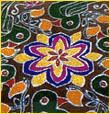


|
|

|
|
| HOME | DIWALI SPECIAL | |||
 CUSTOMS OF DIWALI  The festival of Diwali is marked by several customs. Each custom has several symbolic meanings. Present-day Diwali is characterised by a combination of traditional customs and contemporary forms of celebration. Diyas and lights Deepavali, as the name suggests, is a festival of light and illumination. There are many reasons that can be attributed for the use of diyas during Diwali. The lighting of lamps is a form of obeisance to god for the attainment of health, wealth, knowledge, peace, valour and fame. In our times, electric bulbs and lamps supplement the traditional diyas.  Diwali is also considered a harvest festival (it coincides with the harvest of the Kharif crop). It is thus also celebrated as the New Year since all activities in traditional agrarian societies like India are linked to farming cycles. In this context, illumination depicts the start of something "new". It also expresses the hope of a good year ahead.
Diwali is also considered a harvest festival (it coincides with the harvest of the Kharif crop). It is thus also celebrated as the New Year since all activities in traditional agrarian societies like India are linked to farming cycles. In this context, illumination depicts the start of something "new". It also expresses the hope of a good year ahead.
According to the Ramayana when, Rama, Sita and Laxmana returned to Ayodhya after completing 14 years of exile, the citizens welcomed them by lighting up the city with lamps. Also, to show Rama's party the way into the city, the citizens lit diyas all the way from the outskirts of the kingdom to the heart of Ayodhya. Rangoli Beautifying one's house is a very important part of Diwali. Houses are thoroughly cleaned and are often whitewashed. They are also decorated with flowers. Rangoli refers to the traditional designs that decorate the entrances of houses during this period.  It is believed that during Laxmi Puja, the Goddess Laxmi actually enters the household. The beautiful Rangoli designs are created to please her, in the hope that she may bless the house. In fact, a special Rangoli depicting Goddess Laxmi's feet is also drawn. Particular attention is given to the fact that the direction of the feet should be towards the entrance, to symbolise Laxmi (wealth) entering the house and to ensure that she stays for the full year. Interestingly, during Ganesh Chaturthi, the feet are depicted pointing outwards, to show that he leaves the household to come back the next year. It is believed that during Laxmi Puja, the Goddess Laxmi actually enters the household. The beautiful Rangoli designs are created to please her, in the hope that she may bless the house. In fact, a special Rangoli depicting Goddess Laxmi's feet is also drawn. Particular attention is given to the fact that the direction of the feet should be towards the entrance, to symbolise Laxmi (wealth) entering the house and to ensure that she stays for the full year. Interestingly, during Ganesh Chaturthi, the feet are depicted pointing outwards, to show that he leaves the household to come back the next year.
Diwali is also a time when friends and relatives visit each others' houses. It is also to welcome them that Rangolis are made and sweetmeats served. Fire Crackers  Originally intended as ways of illumination for the same reasons as diyas, fire crackers "illuminate" much more by sound than by light. In our times, Diwali is synonymous with grand celebrations marked by lavish displays of fireworks.
Originally intended as ways of illumination for the same reasons as diyas, fire crackers "illuminate" much more by sound than by light. In our times, Diwali is synonymous with grand celebrations marked by lavish displays of fireworks.
It is also an occasion when children regale themselves by bursting fire crackers. Interestingly, most of the fire crackers are christened to the beat of mythology, with names like "Laxmi bomb" and a rocket that goes by the name of "Laxman baan" (arrow). Gambling Myth holds that the Goddess Parvati played dice with her husband, Lord Shiva on this day. She is supposed to have stated that all those who gambled on the night of Diwali would experience prosperity for the duration of the coming year. Thus, the tradition of gambing with stakes continues, especially in North India. If you know of any other customs of Diwali or other versions of the customs described above, do share them with us. TOP
|
|
|
HOME |
NEWS |
BUSINESS |
SPORTS |
MOVIES |
CHAT |
INFOTECH |
TRAVEL SHOPPING HOME | BOOK SHOP | MUSIC SHOP | HOTEL RESERVATIONS EDUCATION | PERSONAL HOMEPAGES | FREE EMAIL | FEEDBACK |